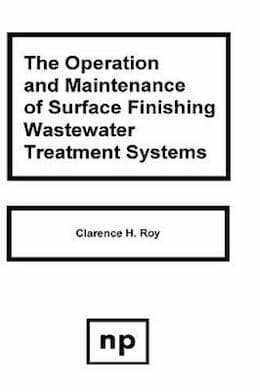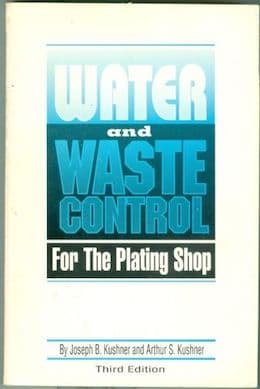
Curated with aloha by
Ted Mooney, P.E. RET

The authoritative public forum
for Metal Finishing 1989-2025

-----
The composition of Electroplating wastewater
Q. Hi,
I'm a researcher at the Cukurova University-Balcali/Adana/TURKEY. I'm trying to find general electroplating wastewater compositions. Especially Zn, Cu, and Pb concentrations. Thanks for your affinity.
Cukurova University - Adana, Turkey
2001
A. The concentration can vary tremendously depending on the processing method, the types of parts being plated, the metal which is being plated onto the parts, the flow rate used in the rinses, whether any recovery is done on the rinses, etc. The U.S. EPA has funded many studies on this which you should be able to start finding from www.epa.gov.
But if you just want a quick number to start from for order of magnitude, my experience is that the average jobshop generates wastewater that contains from the low to middle double digits of mg/l of the primary metals it plates. In other words, a zinc plating shop will often generate a waste of 15 to 70 mg/l of zinc; higher if they've been working at water conservation. The mg/l of secondary processes seems to run in the middle single digits, like 3-7 mg/l. Metals which are not used as platings, like lead in a shop that does no lead or solder plating seem to run in the low mg/l, like 1-3 mg/l. Again, the numbers could be higher if they are trying to reduce water usage, but probably aren't lower.
Again, this is not science, it's just typical of what I personally have seen, but should be helpful for a hypothetical plating plant for a school project. Good luck.

Ted Mooney, P.E.
Striving to live Aloha
finishing.com - Pine Beach, New Jersey
2001
Q. I need to know the average concentration of Cr+6 in electroplating wastewater according to your experiences, and also the pH of the very wastewater. Please send me a good e-resource.
Amir mousavi radstudent - tehran, Iran
January 18, 2009
A. Hi, Amir. I really don't think there are any meaningful "averages". Some shops do a little hexavalent chromating on zinc plating, using a small amount of quite dilute Cr+6 and have no other use for it. Other shops do chromating of aluminum as a mainstay and use a lot of this rather dilute solution. Still others do hard chromium plating exclusively, using a lot of much higher concentration chromic acid on all of the parts they process. In most countries, probably including yours, there are effluent standards that dictate that this waste must be treated before discharge.
Why are you asking? Are you looking for the numbers before waste treatment, or the concentrations in the effluent? If you want to do a project for a hypothetical plant, please tell us about that hypothetical plant and what they do. If you want average numbers, to decide for example whether a treatment technology would be economically viable, it's simply not going to work. Thanks.
Regards,

Ted Mooney, P.E.
Striving to live Aloha
finishing.com - Pine Beach, New Jersey
January 19, 2009
A. Electroplating industries discharge different heavy metals according to the type of metal solution used in the process. The concentration of hexavalent chromium can be found in the range of 700-1500 mg/l in wastewater. Nickel concentration can reach 150-400 mg/l in wastewater.
Mohammed Wateery- MYSORE, India
May 22, 2009
Thanks Mohammed. Your numbers are before wastewater treatment of course, and could apply to a decorative nickel-chrome plating shop. I doubt that a shop whose mainstay is zinc plating would reach numbers approaching that :-)
Regards,

Ted Mooney, P.E.
Striving to live Aloha
finishing.com - Pine Beach, New Jersey
Multiple threads merged: please forgive chronology errors and repetition 🙂
by Clarence Roy

on AbeBooks
or eBay or
Amazon
(affil links)
by Kushner & Kushner

UTL on eBay
UTL on AbeBooks
on Amazon
(affil links)
Q. Hi! My name is andy Li. I am an Environmental Engineer in Taiwan. I read your discussion on WWW. May I have some question?
1. Why most companies in the States send their concentrated to outside recycler and do not treat concentrated on site? Is that causing any problem in their treatment plant? And what is the problem? (for cyanide and Cr, Cu....)
2. What is the typical concentration of the rinse water and concentrated?
3. How the sludge be treated by you and your recycler?
Very appreciate your help. Thanks!
Andy LiTaiwan
1996
A. Hello Li. I do not agree that most shops send their concentrated waste off site, but when they do ...
1). In my opinion there are three main reasons concentrated wastes are shipped off-site:
a). because the particular waste is especially difficult to treat while remaining in compliance with permits--for example, nickel cyanide wastes and electroless nickel wastes;
b). because of questions about the legality of treating them--some misguided regulatory authorities believe that the purpose of wastewater treatment systems is to treat dilute rinse waters, and shop managers are afraid of running afoul of their interpretation.
c). because the particular waste has good economic value that shouldn't be wasted, like silver and gold.
2). Concentrated wastes are usually the same strength as the plating bath, acid tank, chromate, or cleaner. Dilute wastes from rinse water can vary tremendously but, in order of magnitude, are probably diluted between 100:1 to 1000:1 compared to the original plating bath.
3). Sludges are not treated by platers, except for removing some of the water. Most recycling companies probably kiln the waste and then use it as a raw material in traditional refining processes.

Ted Mooney, P.E.
Striving to live Aloha
finishing.com - Pine Beach, New Jersey
1996
Q. I have a sample of a zinc plating wastewater which presents a high level of BOD (7.000 mg/L). What could be the origin of this organic matter? Detergents maybe? Does it make sense to you?
Thanks in advance.
- Santiago, Chile
March 29, 2012
A. Firstly, 7. mg/l O2 is a pretty low BOD. Did you mean 700, or 7,000?
Secondly, lots of brighteners used in Zn plating are organic acids, aldehydes, etc. that will be readily metabolized by bacteria. To lower your number, you might try preoxidation with H2O2. Or, you could chlorinate; that might give rise to other problems, though.

Dave Wichern
Consultant - The Bronx, New York
April 3, 2012
Q. Hi sir,
I need to know how to find acid composition in electroplating wastewater.
- New Delhi, INDIA
July 14, 2016
![]() Hi Manish. You know whether you are an elementary school student, a post-doc, a regulator, author of a book on environmental engineering, chemist in a lab, wastewater treatment system operator, designer of lab instrumentation, etc. -- but we don't, so there is no way anyone can respond at shorter than book length.
Hi Manish. You know whether you are an elementary school student, a post-doc, a regulator, author of a book on environmental engineering, chemist in a lab, wastewater treatment system operator, designer of lab instrumentation, etc. -- but we don't, so there is no way anyone can respond at shorter than book length.
Please spend more time on your own behalf in describing your situation and in composing your question than you would ask a stranger to spend on your behalf and I'm confident that you will get good answers. You're about 8 minutes in the hole :-)
Thanks for your understanding.
Regards,

Ted Mooney, P.E. RET
Striving to live Aloha
finishing.com - Pine Beach, New Jersey
July 2016
Q. You stated that dilute wastes (rinse water) can vary in order of magnitude between 100:1 to 1000:1 compared to the original plating bath.
Let's say a tank make up is 10 oz./gallon (chromic acid); using the 100:1 magnitude, then the concentration of hex-chrome in the rinse would be 0.1 oz/gallon, right?
What would be the concentration in ppm?
Thanks for your answer.
wastewater operator - Los Angeles
October 17, 2019
A. Hi Mike. A gallon of water weighs approximately 8.34 pounds, i.e., 133.44 oz. So 0.1 oz/gal would be 0.1/133.44 = 0.000749 or 749 ppm.
1000:1 dilution would be a better guess for chrome plating, so 1000:1 dilution would give you, say, 75 ppm. That sounds believable to me. Good luck.
Regards,

Ted Mooney, P.E. RET
Striving to live Aloha
finishing.com - Pine Beach, New Jersey
October 2019
Q, A, or Comment on THIS thread -or- Start a NEW Thread